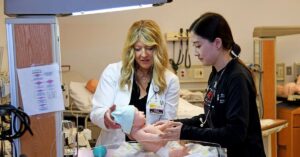Nursing has always been the backbone of healthcare, offering care, compassion, and commitment that make the profession more than just a clinical role. For decades, traditional nursing frameworks have guided practice, providing structure and order to a complex system. These frameworks shaped the professional identity of nurses, standardised care, and ensured consistency in patient treatment. While their contributions remain valuable, the world of healthcare has changed dramatically, and it is increasingly clear that the old systems are no longer sufficient.
Patients today are not the same as those who relied on healthcare a century ago. They live longer, manage multiple chronic conditions, demand more personalised care, and expect healthcare systems to embrace inclusivity and innovation. At the same time, nursing professionals face burnout, staffing shortages, and overwhelming responsibilities that traditional models cannot fully address. Sticking rigidly to outdated frameworks risks leaving both patients and professionals underserved.
This article explores why it is time to break free from traditional nursing frameworks and embrace a shift toward more adaptive, technology-driven, and patient-centred models. By reviewing historical foundations, identifying current challenges, and envisioning future solutions, we can understand how nursing must transform to thrive in the 21st century.
In This Article
Traditional Nursing Frameworks – Foundations and Limitations
Traditional nursing frameworks have long served as the backbone of clinical practice, offering structure, guidance, and consistency in patient care. Rooted in historical theories and models, they established nursing as a recognised profession and provided clear standards for assessment, planning, and evaluation. While these frameworks brought order and legitimacy to nursing, their rigid structures often struggle to meet the diverse, fast-changing demands of modern healthcare.
Historical Origins of Nursing Frameworks
The roots of nursing frameworks can be traced back to Florence Nightingale in the 19th century. She introduced environmental principles to nursing care, emphasising cleanliness, fresh air, and nutrition. Her model provided structure at a time when nursing was not recognised as a scientific discipline. In the 20th century, scholars developed theories such as Orem’s self-care model and Roy’s adaptation model, which sought to give nursing a clear academic and professional identity.
Key Traditional Frameworks in Use Today
- The Nursing Process (ADPIE): Assess, Diagnose, Plan, Implement, and Evaluate remains the most widely taught model.
- Orem’s Self-Care Deficit Model: Focuses on assisting patients unable to care for themselves.
- Roy’s Adaptation Model: Views patients as adaptive systems responding to environmental changes.
- Neuman Systems Model: Considers patients as holistic beings with physiological, psychological, sociocultural, and spiritual needs.
These models offered structured methods of delivering care, ensuring consistency across institutions.
Strengths of Traditional Frameworks
- Standardisation ensured quality and safety.
- Provided academic legitimacy to nursing as a profession.
- Encouraged holistic perspectives on patient health.
Limitations in the Modern Context
- Overemphasis on documentation rather than patient interaction.
- Frameworks designed for simpler healthcare systems, not today’s globalised, tech-driven environment.
- Limited flexibility in addressing complex, multicultural patient needs.
Traditional frameworks served as steppingstones, but they often leave nurses tied to rigid checklists instead of adaptive care.
Why the Shift is Necessary
The healthcare landscape today looks very different from when traditional nursing frameworks were first introduced. Patients live longer, technology drives care delivery, and nurses face unprecedented challenges such as burnout and workforce shortages. While older models offered structure, they often fail to adapt to the complexities of modern care. A shift is necessary to ensure nursing remains responsive, patient-centred, and resilient in an evolving global health environment.
Changing Patient Demographics and Expectations
Modern healthcare involves managing diverse populations with varied cultural, linguistic, and social needs. Ageing populations bring chronic conditions like diabetes and dementia, requiring long-term, person-centred care. Patients now expect not only treatment but also education, prevention, and empowerment in their healthcare journey.
Technology Disruptions
Artificial intelligence, electronic health records, telehealth, and wearable monitoring devices are reshaping care delivery. Traditional frameworks do not account for how nurses must interpret, manage, and apply data in real time. Nursing is no longer just bedside it extends into virtual care environments.
Workforce Challenges
The nursing workforce is under immense strain, with shortages worsening globally. Burnout, long shifts, and emotional fatigue are common. Traditional frameworks rarely consider the wellbeing of nurses themselves, focusing exclusively on patient outcomes.
Global Health Trends
The COVID-19 pandemic highlighted weaknesses in rigid systems. Nurses had to adapt quickly, improvising care approaches beyond traditional frameworks. This demonstrated the importance of flexible, resilient models that can respond to crises, community health needs, and prevention-oriented care.
Emerging Paradigms in Nursing
As healthcare systems evolve, nursing is moving beyond rigid, traditional frameworks toward more dynamic and inclusive approaches. Emerging paradigms focus on patient-centred care, digital integration, and collaborative practice, ensuring that nurses are not just task performers but active partners in health outcomes. These new models prioritise flexibility, prevention, and holistic support, enabling nursing to meet the diverse and complex needs of modern patients while embracing innovation and compassion.
Person-Centred and Holistic Models
A shift from “disease-focused” care toward person-centred care recognises patients as partners. Nurses now focus on values, preferences, and cultural sensitivities rather than treating all patients with identical frameworks.
Interdisciplinary Collaboration
Modern nursing must operate within team-based care systems. Nurses collaborate with doctors, therapists, social workers, and tech professionals. Moving away from hierarchical models allows nurses to have a stronger voice in clinical decisions.
Technology-Integrated Care
Digital innovations are no longer optional. AI-driven diagnostic tools, electronic health records, and telemedicine consultations mean nurses must possess digital literacy. Flexible frameworks must incorporate continuous training and tech integration.
Preventive and Community-Focused Nursing
Instead of focusing only on illness management, emerging frameworks prioritise prevention. Public health campaigns, community education, and lifestyle coaching are becoming key nursing roles.
Case Studies and Real-World Evidence
Theories and proposals for new nursing frameworks gain real value when tested in practice. Across the world, healthcare systems and hospitals are experimenting with innovative approaches that empower nurses, integrate technology, and improve patient outcomes. These case studies provide concrete evidence of how moving beyond traditional frameworks can enhance care quality, reduce stress on professionals, and create more resilient healthcare environments for the future.
Countries Redefining Nursing Roles
- United States: Nurse practitioners fill gaps in primary care, offering autonomy and prescribing rights.
- United Kingdom: Advanced nurse prescribers reduce pressure on doctors by independently managing patients.
- Australia & Canada: Expanded nursing roles include advanced practice nurses leading chronic disease management.
Hospital Systems Adopting Flexible Frameworks
Magnet-recognised hospitals in the US emphasise nurse autonomy, professional development, and collaborative decision-making, leading to higher patient satisfaction and better retention rates.
Technology-Driven Nursing Innovation
Hospitals using AI triage tools and remote patient monitoring report improved efficiency and early detection of complications. For instance, wearable devices alert nurses to irregular heart rhythms or oxygen desaturation, enabling rapid interventions.
Key Pillars of the Future Nursing Framework
- Flexibility and Adaptability
- Nurses must adjust care plans quickly based on evolving patient needs.
- Frameworks must support customisation over standardisation.
- Cultural Competence and Inclusivity
- Nurses should embrace patient diversity by respecting beliefs, language, and traditions.
- Training must include cultural sensitivity as a core skill.
- Digital Integration
- Future frameworks require competency in electronic records, telehealth, and AI interpretation.
- Nurses must blend empathy with technological efficiency.
- Emotional and Mental Wellbeing of Nurses
- Frameworks should include strategies to reduce burnout.
- Support systems like peer counselling, shorter shifts, and wellbeing programmes are essential.
- Continuous Education and Innovation
- Lifelong learning must be integrated into nursing culture.
- Frameworks should evolve alongside medical and technological progress.
Challenges to Transformation
- Resistance to Change in Institutions
- Hospitals rooted in tradition resist innovation.
- Bureaucratic systems often slow adoption of modern frameworks.
- Training and Resource Limitations
- Upskilling nurses requires time and financial investment.
- Developing countries may lack infrastructure for digital nursing.
- Ethical and Privacy Concerns with Technology
- Patient data security is critical.
- Nurses must balance efficiency with protecting confidentiality.
- Policy and Regulation
- Laws often lag behind practice.
- Nurse practitioners may face restrictions despite proven effectiveness.
Roadmap for Change
Shifting away from traditional nursing frameworks requires more than recognising their limitations it demands a clear, actionable plan. A roadmap for change must focus on education, leadership, technology, and community engagement to build systems that support both patients and professionals. By outlining practical steps, healthcare can move from rigid structures to flexible, innovative frameworks that prepare nursing for the future of care.
Educational Reforms
- Updating nursing curricula to include digital literacy, data interpretation, and critical thinking.
- Encouraging innovation, not just adherence to traditional frameworks.
Policy and Leadership Support
- Governments and healthcare leaders must empower nurses to make autonomous decisions.
- Investment in nurse-led research to create modern frameworks.
Technology Partnerships
- Hospitals must collaborate with technology companies to develop user-friendly tools.
- Nurses should be involved in the design of healthcare technologies.
Community Engagement
- Frameworks should incorporate patient and family voices.
- Co-designed models ensure relevance and inclusivity.
Comparative Table
| Aspect | Traditional Nursing Frameworks | Future Nursing Frameworks |
|---|---|---|
| Focus | Standardisation, documentation | Flexibility, personalisation |
| Technology | Minimal integration | Digital-first, AI-supported |
| Patient Role | Passive recipient | Active partner in care |
| Nurse Role | Task-oriented | Decision-maker, innovator |
| Scope | Hospital-centric | Community and global health |
Must Read:
- Next-Gen Nursing: Strategic Moves for Nurse Leaders
- Expansion of Nurse Licensure Compact (NLC)
- Demand for Geriatric Nursing Specialists
Conclusion:
Traditional nursing frameworks were vital in shaping the profession and ensuring safety, but they cannot keep up with the demands of modern healthcare. Patient diversity, global health crises, workforce pressures, and rapid technological innovations require a new approach. Breaking free from rigid structures does not mean discarding tradition entirely—it means building on strong foundations to create adaptive, inclusive, and forward-looking systems.
The shift is not optional; it is a necessity. Nurses, educators, policymakers, and leaders must come together to create frameworks that value both patients and professionals. The future of nursing lies in embracing flexibility, cultural competence, digital integration, and emotional resilience. By doing so, nursing can continue to be not only the heart of healthcare but also its most innovative force.







